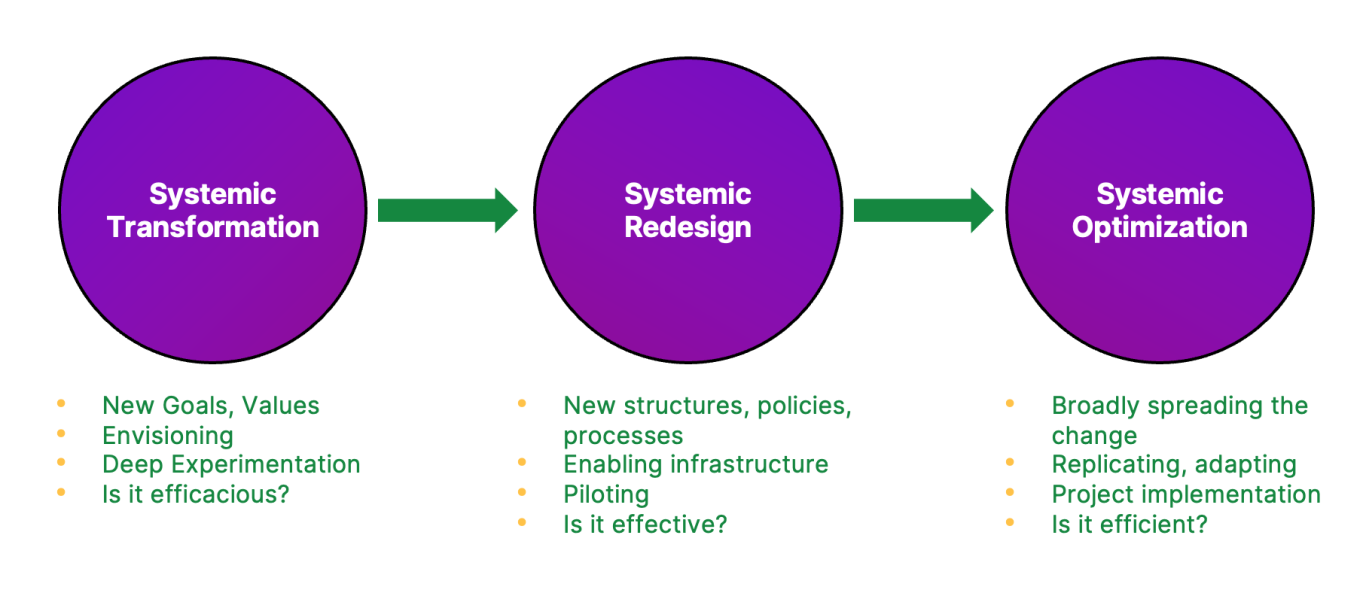The Three Types of Systems Change Finance
People are using "systems change finance" in three very different ways. There is systemic transformation finance, altering systems finance, and optimizing systems finance.
Systems change and transformation are often used with a confusion of definitions. Distinguishing between three types of systems change is important for developing the distinctive strategies, tools, processes and frameworks associated with transformation goals.
Work on transformation, change and transitions has, by and large, settled upon three different types or stages of change to realize broad shift to a new paradigm. One tradition comes from the management sciences, rooted in work beginning in the 1970s with Chris Argyris at MIT that sees three distinctive types of learning: single-, double-, and triple-loop. Then those working in the biological sciences about 25 years later distinguished between three different types of change in response to changes in the natural environment, such as climate change, with adaptation, resilience and transformation. About the same time, with the emergence of socio-technical sciences associated with transitions, a multi-level perspective developed comprising niches, regimes and landscapes. In parallel, building on Argyris framework with large systems change to broad societal-environmental issues, a framework was developed of incremental change, reform, and transformation. Work on complexity brought out the value of distinguishing between simple, complicated and complex (and chaotic). All this while the importance of systems thinking for change was being advanced with particular fervour by Peter Senge, the Society for Organizational Learning and its associated organization the Presencing Institute.
The Graphic and Table Three Types of Systems Change (below) aim to integrate all this valuable work, using “systems” as the common reference point. Therefore, the types of change are labelled in response to the question: How does the type of change effort affect a system?


Transformation by its very nature requires addressing challenges of great complexity, significant scale and substantial lengths of time. It involves moving from, in the Table’s typology, systemic transformation to systems alteration to optimizing the (new) system. This process is seen at work with the energy transition: it began with identifying through experiments the technological, policy and other innovations needed to support a net-zero energy approach; the emphasis has moved to creating the supportive operating environment with system alteration, such as development new policy, electricity grids and networks for charging electric vehicles; this is necessary for the optimization of the new system which then involves replication and adaptation.
This is, of course, a simplistic description. Around any one issue like clean energy, these three types of change are happening concurrently with different technologies and in different locations. Moreover, more than one type of change system is often involved. In such cases, the technology is developed but the financing transformation necessary for its implementation holds things back.
Different types of financing are required for these three types of change. Financing systemic transformation requires developing and applying the appropriate financing approach for the type of systems change. The unprecedented scale of need for transformation in response to the polycrisis demonstrates both the scale and type of financing available for this is greatly inadequate. The vast majority of financing is optimizing the old system. Moreover, the relationships between the three modalities of change finance are poorly connected.
We need your consent to load the translations
We use a third-party service to translate the website content that may collect data about your activity. Please review the details in the privacy policy and accept the service to view the translations.

